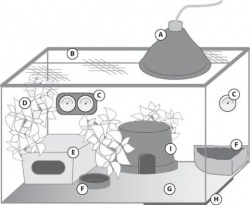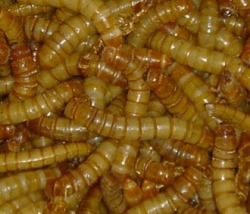Caging Requirements

Cage Size: 10 gallon glass aquariums can house one leopard gecko. Males can not be kept in the same cage because they can fight which could end up on fatalities, so keep males in cages alone. Females can be housed together. 10 gallon can still only house one female but a twenty gallon can house up to 2 - 3 females if you would like to keep them together. Bigger cages than that can be used but i do not recommend using them because usually the gecko will not be able to find food which can end in death. Tubs are another option for leopard gecko caging. 12 - 16 quart tubs can house one adult leopard gecko.
Heating: Heat pads are the easiest way to heat your leopard gecko. Heat lights can be used but heat pads are easier, cheaper, and give better hot spots for your leopard gecko to get warm.
Caging Decor: Leopard geckos need a hide box to make them feel secure so they can hide during the day since they are nocturnal. There should be one hide box on the warm side and one on the cold so the gecko can hide in peace if it gets to hot in the hide on the warm side. You will also need a water dish to give the gecko water. Your water dish does not need to be huge because geckos do not soak in their water dish like some other reptiles. A circular water dish with at least a two inch diameter that is a half of an inch deep will be the perfect size. Depending on what you are feeding your gecko you might need a food dish to keep you worms contained but if you are feeding crickets this item is not necessary. No other items are required. You can put sticks and leaves in the cage to make it look cool but the gecko will most likely not even climb on them.
Heating: Heat pads are the easiest way to heat your leopard gecko. Heat lights can be used but heat pads are easier, cheaper, and give better hot spots for your leopard gecko to get warm.
Caging Decor: Leopard geckos need a hide box to make them feel secure so they can hide during the day since they are nocturnal. There should be one hide box on the warm side and one on the cold so the gecko can hide in peace if it gets to hot in the hide on the warm side. You will also need a water dish to give the gecko water. Your water dish does not need to be huge because geckos do not soak in their water dish like some other reptiles. A circular water dish with at least a two inch diameter that is a half of an inch deep will be the perfect size. Depending on what you are feeding your gecko you might need a food dish to keep you worms contained but if you are feeding crickets this item is not necessary. No other items are required. You can put sticks and leaves in the cage to make it look cool but the gecko will most likely not even climb on them.
Feeding

Diet: A leopard gecko can eat a wide variety of insects. The most commomly fed food is the mealworm. Mealworms are a good source of nutriens that the leopard geckos need to live. Mealworms are the easiest food choice since they can be feed all the way from hatchling to adult. Mealworms can be kept in a dish so the gecko can eat when they wish. Baby geckos can eat 3 1'' long mealworms every other day, juveniles geckos can eat 5-6 1'' to 1 1/2'' mealworms daily, and adults can eat 10-12 1'' to 1 1/2'' mealworms daily. Crickets can be an alternative of mealworms. They come in three sizes that are all work for a certain age group of leopard gecko. Baby geckos can eat 5 small crickets daily, juveniles can eat 5-7 medium crickets every day to every other day, and adults can eat 3-4 large crickets daily. Treats can be offered occasionally to your gecko. Waxworms are like donuts to us but for them. Waxworms are very fatty so they are usually a good weekly treat. 3 waxworms are a good amount to feed your gecko. Super worms are like big mealworms but they have a softer outer shell and they are much bigger. Super wroms are a good way to get your gecko fattened up for breeding. Don't feed more than 2-3 every few days because if there are to many superworms in there stomach they might regurgitate. Other worms like butter worms, silk worms, and pheonix worms can also be fed to the geckos as treats. One food item that female geckos that are just about to breed or have just laid eggs are pinkie mice. They are a great source of fat and nutrients that are very good for a skinny gecko. Frozen thawed are the best way to get them but live can also be fed.
